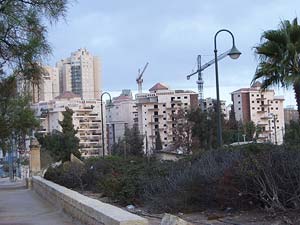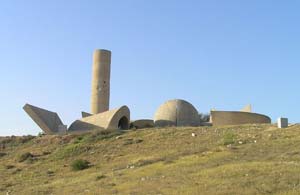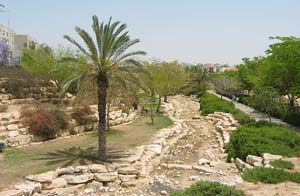Beersheba
 |
| Beersheba |
Beersheba is the largest city in the Negev desert of southern Israel. Often referred to as the "Capital of the Negev", it became the sixth largest city in Israel in 2008 when the population reached 202,208. Located in the Southern District of the country, the city is the district's administrative centre and is home to the Ben-Gurion University of the Negev, the Soroka Medical Center, and the Israel Sinfonietta Beersheba.
In the post-Biblical era, Beersheba only regained importance in the 19th century, when the Ottoman Turks built a regional police station there. This quickly expanded into a small town, and became a strategic point in World War I. Then a predominantly Arab town known as Bir Seb'a, it was allocated to the Arab state in the 1947 Partition Plan. Soon after the Arab rejection of the United Nations resolution, the surrounding Arab countries invaded Israel following its declaration of independence (May 1948) and Beersheba became an important strategic and logistical point for the Egyptian army. The city was conquered by the Israel Defense Forces on 21 October 1948 in Operation Yoav, and has remained an Israeli city since.
Beersheba has grown considerably since Israeli independence in 1948; a large portion of the population is made up of Jews who immigrated from Arab countries after 1948, and has been significantly boosted since 1990 by newcomers from Ethiopia and the former Soviet Union. The city is surrounded by a number of satellite towns including the predominantly Jewish Omer, Lehavim and Meitar, and the Bedouin towns of Rahat, Tel as-Sabi and Lakiya.
 |
Tel Be'er Sheva archaeological site |
History
Prehistory and Biblical Era
From the findings unearthed at Tel Be'er Sheva, an archaeological site a few kilometers northeast of modern day Beersheba, it is believed that the region has been populated since the 4th millennium BC. The city was destroyed and rebuilt many times over the centuries.
Beersheba was the southernmost city of Israel in Biblical times, hence the expression "from Dan to Beersheba" to describe the whole kingdom. Beersheba is mentioned in the Book of Genesis in connection with Abraham the Patriarch and his pact with Abimelech. Isaac built an altar in Beersheba (Genesis 26:23-33). Jacob had his dream about a stairway to heaven in the area of Beersheba. (Genesis 28:10-15 and 46:1-7). Beersheba was the territory of the tribe of Shimon and Judah (Joshua 15:28 and 19:2). The prophet Elijah took refuge in Beersheba when Jezebel ordered him killed (I Kings 19:3). The sons of the prophet Samuel were judges in Beersheba (I Samuel 8:2). Saul, Israel's first king, built a fort for his campaign against the Amalekites (I Samuel 14:48 and 15:2-9). The prophet Amos mentions Beersheba in regard to idolatry (Amos 5:5 and 8:14).
Ottoman Turkish Occupation
The last inhabitants of Tel Be'er-Sheva were the Byzantines, who abandoned the city in the 7th century. The Turkish Ottomans, who had controlled Palestine since the 16th century, took no interest in Beersheba until the end of the 19th century. At the beginning of the 19th century, Beersheba was portrayed by European pilgrims as a barren stretch of land with a well and a handful of Bedouin living nearby.
Towards the end of the 19th century, the Ottomans built a police station in Beersheba in order to keep the Bedouin in check. They built roads and a number of small buildings from local materials which are still standing today. A town plan was created by a Swiss and a German architect, which called for a grid street pattern, a pattern which can still be seen today in Beersheba's Old City. All houses built during that period were of one storey, and the two-storey police station towered above them. Most of the residents at the time were Arabs from Hebron and the Gaza area, although a slew of Bedouin abandoned their nomadic lives and built homes in Beersheba.
During World War I, the Turks built a military railroad from the Hejaz line to Beersheba, inaugurating the station on October 30, 1915. The celebration was attended by the Turkish army commander Jamal Pasha, along with senior government officials. The train line was active until the British took over the region. Later, during Israel's War of Independence, the station was used as the headquarters of the Egyptian Army..
British Mandate Era
Beersheba played an important role in the Sinai and Palestine Campaign in World War I. On October 31, 1917, 800 soldiers of the Australian 4th and Light Horse Brigade, under Brigadier General William Grant, with only horses and bayonets, charged the Turkish trenches, overran them and captured the wells of Beersheba. This is often described as the Battle of Beersheba, and "the last successful cavalry charge in British military history". On the edge of Beersheba's Old City is a Commonwealth cemetery containing the graves of British and Australian soldiers. On the last row on the right, is the grave of Captain Seymour Van den Berg of the Middlesex Hussars, a British Jew who was killed five days before the capture of Beersheba.
Beersheba was a major administrative center during the period of the British Mandate for Palestine.
In 1928, at the beginning of the tension between the Jews and the Arabs over Palestine and wide-scale rioting which left 133 Jews dead and 339 wounded, many Jews abandoned Beersheba, although some returned occasionally. With the Arab attack on a Jewish bus in 1936 which escalated into the 1936–1939 Arab revolt in Palestine, the remaining Jews left Beersheba and did not return until after the battle with the invading Egyptian army in October, 1948.
After Israeli Independence
 |
Monument to the Negev Brigade near the eastern entrance of Beersheba |
The 1947 UN Partition Plan included Beersheba in the territory allotted to the Arab state as the city's population of 4,000 was primarily Arab. The Egyptian Army was stationed in Beersheba in May 1948. Convinced that Beersheba was vital for the security of the Jewish state, Prime Minister David Ben-Gurion gave the green light for Operation Yoav.
On October 21, 1948, at 04:00 in the morning, the 82nd battalion advanced from Mishmar HaNegev junction, 20 kilometres (12 mi) north of Beersheba. Part of the force attacked from the Turkish train station and part from Hatzerim. By 09:45, the Egyptian forces were surrounded, and Beersheba was in Israeli hands. On 20 November Leonard Bernstein and the Israel Philharmonic Orchestra played for the soldiers.
In the 1950s, Beersheba expanded northward. Soroka hospital opened its doors in 1960, and the Negev University, later renamed Ben-Gurion University of the Negev, was established in 1970. In the 1970s, a memorial commemorating the fallen soldiers designed by the sculptor Danny Karavan was erected northeast of the city (approximately 3 kilometres (1.9 mi) from the city entrance) on a hill overlooking the city. The Beersheba Theater opened in 1973, and Egyptian president Anwar Sadat visited Beersheba in 1979.
Arab-Israeli Conflict
For many years, Beersheba remained untouched by attacks from Palestinians. Relations between Jews and Arabs, and especially the large number of Bedouin who live in the region and do business in Beersheba, were good. This equilibrium was shattered on August 31, 2004, when sixteen people were killed in two suicide bombings on buses in Beersheba for which Hamas claimed responsibility. On August 28, 2005, another suicide bomber attacked the central bus station, seriously injuring two security guards and 45 bystanders.
Geography
Beersheba is located on the northern edge of the Negev desert 115 kilometres (71 mi) south-east of Tel Aviv and 120 kilometres (75 mi) south-west of Jerusalem. The city is located on the main route from the center and north of the country to Eilat in the far south. The Valley of Beer Sheva has been populated since thousands of years ago due to the presence of water which travels here from the Hebron Mountains in the winter and is stored underground in vast quantities. The main river in Beersheba is Nahal Beersheva, a wadi which floods in the winter. The Kovshim and Katef streams are other important wadis which pass through the city.
 |
Nahal Ashan, Beersheba |
Climate
Beersheba has very hot summers, with temperature up to 42 °C (110 °F). In the winter, the temperature at night can be as low as 0 °C (30 °F). The average precipitation in the city is 260 mm a year Between summer to winter, Beersheba is prone to sandstorms that cover the whole city in dust. 200-250 tonnes/sqkm of dust are dumped in the area. Fogs and humidity at night are also unique to Beersheba and the Negev region, occurring for some 50% of nights a year and being caused by wet air coming from the sea being trapped under hot, dry air above. The relative humidity in the city reaches 86% through much of August.
Urban Development
Beersheba is divided into seventeen residential neighbourhoods in addition to the Old City and Ramot, an umbrella neighborhood of 4 sub-districts. Many of the neighbourhoods are named after letters of the Hebrew alphabet, which also have numerical value, but descriptive place names have been given to some of the newer neighborhoods. The city also has three main industrial zones: Makhteshim, Emek Sara and Kiryat Yehudit - all in the southeast of the city. An additional light industrial zone is located between Kiryat Yehudit and the Old City. One of the projects under way in Beersheba is the development of a cultural-commercial center in the Old City. The Cultural, Art and Media Center for Young People was built in this part of the city, and the Negev Museum reopened as an art museum. A Science Park funded by the RASHI-SACTA Foundation, Beersheba Municipality and private donors is slated for completion in 2008.